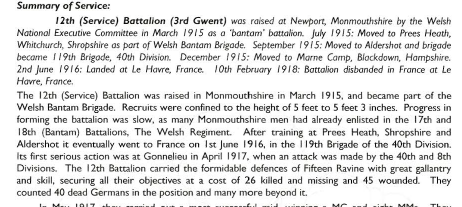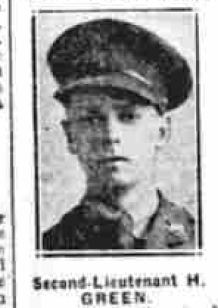Harold Syddall Green was born on 25th January 1889 in Old Whittington, to parents Henry Green and Sarah (Syddall). The family lived on Church Street and Harold was baptised at St Bartholomews Church Old Whittington on April 21st 1889.

Harold’s father Henry’s occupation was given as farmer, but by the 1891 census his occupation has changed and he is now a carpenter and joiner as was Harold’s maternal grandfather, Samuel Syddall. I suppose it was inevitable that later in life it would be the trade that Harold would follow, for a short time at least.
Harold was the middle child of the family having an older sister Julia and a younger baby brother Walter.
Harold started school in April 1892 and attended Websters Endowed (now Mary Swanwick), he is listed next to the bottom entry on the school admission log below.

According to the record Harold left 20th December 1895, when presumably he moved up to the junior class.
Sadly for the family Henry Green, Harold’s father, died 23rd September 1892 at the young age of 43 years, and is buried in St Bartholomews churchyard. Sarah lived a few doors away from her widowed father and her younger brother and sister, which must have been a help to her at this sad time. Tragedy was to strike again however, when Sarah died on January 26th 1900 at 45 years of age.
Sarah’s family rallied around and on the 1901 census you can see that


Harold and his brothers and sisters are living with their maternal uncle Joseph Syddall the talented Whittington artist (and member of the Royal Academy). It would appear that he and his older brother Edmund gave the children a home, although Julia at the age of 21 was probably tasked with looking after them !There were now four siblings Julia 21, Harold 12, Walter 10 and Mary Elizabeth 8.
(Further information on Joseph Syddall can be read here
Harold’s father was a relation of the Green family who established the timber yard at the bottom of Whittington Hill, J H and F W Green Timber Merchants. When Harold left school he went to work for his cousins at the timber yard.
This extract taken from Graces 1914 guide:
GREEN, J. H. & F. W., Timber Merchants and Importers, and Joinery Manufacturers, Whittington, Chesterfield. Hours of Business: Works, 6 a.m. to 5 p.m.. Office, 8 a.m. to 5 p.m.; Saturdays, close at 12 noon. Established in 1830 by William Green, continued by John Green. Present Principals: John Henry Green, J.P. and F. W. Green (grandsons). Premises: Home Mill and Office cover two and a half acres, with siding attached. Equipped with a permanent Sawing Plant at Whittington for Home Grown Timber and Moulding and Joinery Machinery Plant for the Manufacture of Joinery, also Four Portable Mills constantly working in the woods in different parts of the country. Staff: 150 to 200. Business: Timber Merchants and Importers, also Joinery Manufacturers. Connection: United Kingdom (extensive), Importers of Timber from Archangel, Riga, and Kotka. Telephone: No. 27, Chesterfield. Telegraphic Address: ” Green Brothers, Whittington Moor.” Code Wood. Bankers: Sheffield Banking Co., Ltd. (Chesterfield). Mr. J. H. Green is Chairman of the Whittington and Newbold Urban District Council and is a Justice of the Peace for the County of Derby, Chairman of the Chesterfield Agricultural Society and Member of the Whittington Endowed School Trust. Mr. J. H. Green is a member of the Scarsdale Lodge of Freemasons. Mr. F. W. Green is a member of the Cavendish Lodge of Freemasons.
The timber yard and saw mill can be seen on the right after the railway line on the map below.
Map courtesy of Chesterfield Local Studies library
The extract above regarding Greens timber yard states that the company had four portable mills operating in different parts of the country. That may explain why on the 1911 census Harold is living and working in Wales as a timber sawyer. He is lodging with Elias Newton and his wife. Elias came from Whittington and when I checked the 1901 census for him, he lived on Whittington Hill and was a Timber Merchants apprentice. It would appear that they were both possibly working for Greens at one of these portable mills. It is just an assumption I have no evidence to confirm that.
Llanwrst is on the edge of what is now Snowdonia National park.
1914 saw the outbreak of the war and not long after the war started Harold joined up. There is no service record for him but a newspaper article at the time of his death reports “he joined up not long after the outbreak of war”. He must still have been living in Wales and he joined what at that time was a Territorial Force, the Denbighshire Hussars, his Regimental number was 215478. Although it was a ‘home force’ members could elect to fight overseas and many volunteered for Imperial Service.
I cannot trace if this is what Harold chose to do but on 18th December 1916 he gained a commission as a 2nd Lieutenant and transferred to the 12th Battalion South Wales Borderers Regiment. According to the newspaper report he was sent to France in February 1917. The 12th Battalion were under orders from the 119th Brigade, 40th Division.
The 2nd Lieutenant was the lowest ranking officer and was normally a position held by young ex-public schoolboys. There was a high mortality rate amongst them, as they would normally be the first person ‘over the top’ and the last one to retreat.
I have been unable to trace an online war diary for the South Wales Borderers, but a report on the 12th Battalion produced by the Regimental Museum of the Royal Welch describes the battle Harold was probably involved in.

Fifteen Ravine was so called because originally the ravine was bordered by 15 trees. The ravine lays south of the small village of Villers-Plouich, close by there is now a cemetery named after it – Fifteen Ravine British Cemetery.
Harold was wounded on 21st April 1917 and died on the 1st May 1917. He was most probably taken to a Casualty Clearing Station as he was buried at St Marie Cemetery in Le Havre , more information here :
https://www.cwgc.org/find-a-cemetery/cemetery/2008000/ste.-marie-cemetery,-le-havre/
Picture courtesy of https://www.ww1cemeteries.com
The grave registration report list soldiers of many different ranks and regiments which would possibly help to confirm that Harold was taken to a clearing station and not buried anywhere near where he fell. On the grave report Harold’s initials have been altered to F S Green, no idea why just an administration error at a very overwhelming time I imagine.
 The War Office sent a telegram to the family which was received by Harold’s sister Julia at Church Street , (now Mrs R Hall, Julia having got married in 1914).
The War Office sent a telegram to the family which was received by Harold’s sister Julia at Church Street , (now Mrs R Hall, Julia having got married in 1914).
The Derbyshire Times report states that Harold had died of the wounds he received on 21st April. He had a fracture of the right thigh and was also shot through the left knee, he passed away on 1st May 1917, he was 28 years old.
Picture taken from Derbyshire Times 5th May 1917
Harold’s younger brother Walter had also been in France, but had by now been sent home and was working in munitions.
Harold’s medal card shows the date of his commission and that he was awarded the British War and The Victory medals. It also shows that his brother was still living at Church Street and the medals were sent out to him on the 27th July 1922. The date 18/2 is most probably the date he arrived in France.

Walter married Annie Kirk at Old Whittington church in 1920. In 1939 they were living at the Nags Head at Newbold, Annie was licensee and Walter was a Railway Vehicle Foreman.
Harold is remembered on Old Whittington and the Brushes war memorials.

 Derbyshire Times 5th May 1917
Derbyshire Times 5th May 1917




